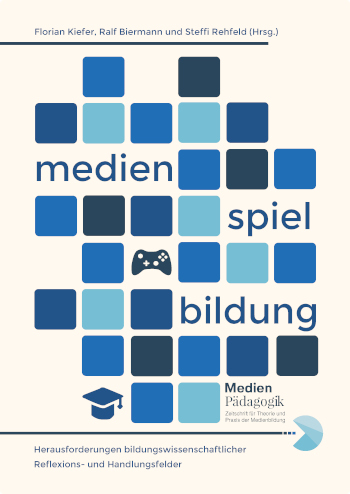Abstract
Otome games are dating simulations that enable players to experience a love story with a fictional character. Based on the assumption that the games potentially convey the illusion of a social interrelationship, the article would like to deepen the understanding of the subject with the help of the term parasocial interaction (based on Horton and Wohl 1956). The question of how otome games can stage their characters and thus potentially offer parasocial interactions will be investigated. In particular, the structure of the games will be examined with the help of the neo-formalist computer game analysis (see Fromme and Könitz 2014). Above all, the interactive medium manifests itself in the options of addressing the players directly by name and thus involving them in the game. The constantly showing of the main characters (e.g. constant eye contact, able to simulate media communication in the form of chats and calls) also offers new possibilities for parasocial interactions. Despite these options, the interaction remains limited and one-sided, as the characters cannot respond to the needs of the users.
References
Bordwell, David, und Kristin Thompson. 2012. Film Art: An Introduction. 10. Aufl. New York: McGraw-Hill.
Cheritz. 2016. Mystic Messenger. Mobile. Seoul: Cheritz.
CYBIRD. 2015. Ikemen Sengoku Otome Game. Mobile. CYBIRD.
Fromme, Johannes. 2017. «Computerspiele». In Grundbegriffe Medienpädagogik, herausgegeben von Bernd Schorb, Anja Hartung-Griemberg, und Christine Dallmann, 6., neu verfasste Auflage, 66–74. München: kopaed.
Fromme, Johannes, und Christopher Könitz. 2014. «Bildungspotenziale von Computerspielen – Überlegungen zur Analyse und bildungstheoretischen Einschätzung eines hybriden Medienphänomens». In Perspektiven der Medienbildung, herausgegeben von Winfried Marotzki und Norbert Meder, 27: 235–86. Medienbildung und Gesellschaft. Wiesbaden: VS Verlag für Sozialwissenschaften. https://doi.org/10.1007/978-3-658-03529-7_11.
Fromme, Johannes, und Alexander Unger. 2012. «Computer Games and Digital Game Cultures: An Introduction». In Computer Games and New Media Cultures. A Handbook of Digitale Games Studies., herausgegeben von Johannes Fromme und Alexander Unger, 1–28. Dordrecht: Springer Netherlands. https://doi.org/10.1007/978-94-007-2777-9_1.
Furniss, Maureen. 2014. Art in motion: animation aesthetics. Animation Aesthetics. Revised Edition. New Barnet: John Libbey Publishing.
Galbraith, Patrick W. 2011. «Bishōjo Games: ‹Techno-Intimacy› and the Virtually Human in Japan». Game Studies 11 (2). http://gamestudies.org/1102/articles/galbraith.
Grace, Lindsay D. 2017. «Love, Lust, Courtship and Affection as Evolution in Digital Play». DiGRA ’17 - Proceedings of the 2017 DiGRA International Conference 1 (14). http://www.digra.org/wp-content/uploads/digital-library/123_DIGRA2017_FP_Grace_Affection.pdf.
Hartmann, Tilo. 2016. «Mass Communication and Para-Social Interaction: Observations on Intimacy at a Distance». In Schlüsselwerke der Medienwirkungsforschung, herausgegeben von Matthias Potthoff, 75–84. Wiesbaden: VS Verlag für Sozialwissenschaften. https://doi.org/10.1007/978-3-658-09923-7_7.
Hartmann, Tilo, Christoph Klimmt, und Peter Vorderer. 2001. «Avatare: Parasoziale Beziehungen zu virtuellen Akteuren». Medien & Kommunikationswissenschaft 49 (3): 350–68. https://doi.org/10.5771/1615-634x-2001-3-350.
Hartmann, Tilo, Holger Schramm, und Christoph Klimmt. 2004. «Personenorientierte Medienrezeption: Ein Zwei-Ebenen-Modell parasozialer Interaktionen». Publizistik 49 (1): 25–47. https://doi.org/10.1007/s11616-004-0003-6.
Horton, Donald, und Anselm Strauss. 1957. «Interaction in Audience-Participation Shows». American Journal of Sociology 62 (6): 579–87. https://doi.org/10.1086/222106.
Horton, Donald, und Richard Wohl. 1956. «Mass Communication and Para-Social Interaction: Observations on Intimacy at a Distance». Psychiatry. Interpersonal and Biological Processes 19 (3): 215–29. https://doi.org/10.1080/00332747.1956.11023049.
Idea Factory, und Design Factory. 2013. AmnesiaTM: Memories. PC. Shibuya: Idea Factory International.
Jörissen, Benjamin, und Winfried Marotzki. 2009. Medienbildung - Eine Einführung: Theorie – Methoden – Analysen. 1. Aufl. Stuttgart: utb GmbH. https://doi.org/10.36198/9783838531892.
Kim, Hyeshin. 2009. «Women’s Games in Japan: Gendered Identity and Narrative Construction». Theory, Culture & Society 26 (2–3): 165–88. https://doi.org/10.1177/0263276409103132.
Koide, Chitoko, und Takashi Obana. 2018. «Otome-gēmu no rekishiteki kenkyū. Kyarakutā bunseki wo chūshin ni [Studie über die Geschichte der Otome-Games: Fokus auf die Charakteranalyse].» Osaka Shoin Women’s University Bulletin 8: 69–74.
Metropolis. 2009. «Love Bytes - Metropolis Japan». 2009. https://metropolisjapan.com/love-bytes/.
NTT Solmare Corporation. 2016. Lost Alice. Mobile. NTT Solmare Corporation.
NTT Solmare Corporation. 2019. Obey Me! Mobile. NTT Solmare Corporation.
Otomate, Idea Factory, und Design Factory. 2020. Piofiore: Fated Memories. Nintendo Switch. Torrance: Aksys Games.
PigeoNation Inc., und Hato Moa. 2011. Hatoful Boyfriend. PC. MIST[PSI]PRESS.
Rubin, Alan M., Elizabeth M. Perse, und Robert A. Powell. 1985. «Loneliness, Parasocial Interaction, and Local Television News Viewing». Human Communication Research 12 (2): 155–80. https://doi.org/10.1111/j.1468-2958.1985.tb00071.x.
Taylor, Emily. 2018. Dating Simulation Games: Romance, Love, and Sex in Virtual Japan. Independently published.
Tosca, Susana, und Lisbeth Klastrup. 2019. «An Experience Approach To Transmedia Fictions». In The Routledge companion to transmedia studies, herausgegeben von Matthew Freeman und Renira Rampazzo Gambarato, 392–400. London: Routledge.
Wegener, Claudia. 2008. «Parasoziale Interaktion». In Handbuch Medienpädagogik, herausgegeben von Uwe Sander, Friederike von Gross, und Kai-Uwe Hugger, 294–96. Wiesbaden: VS Verlag für Sozialwissenschaften. https://doi.org/10.1007/978-3-531-91158-8_43.

